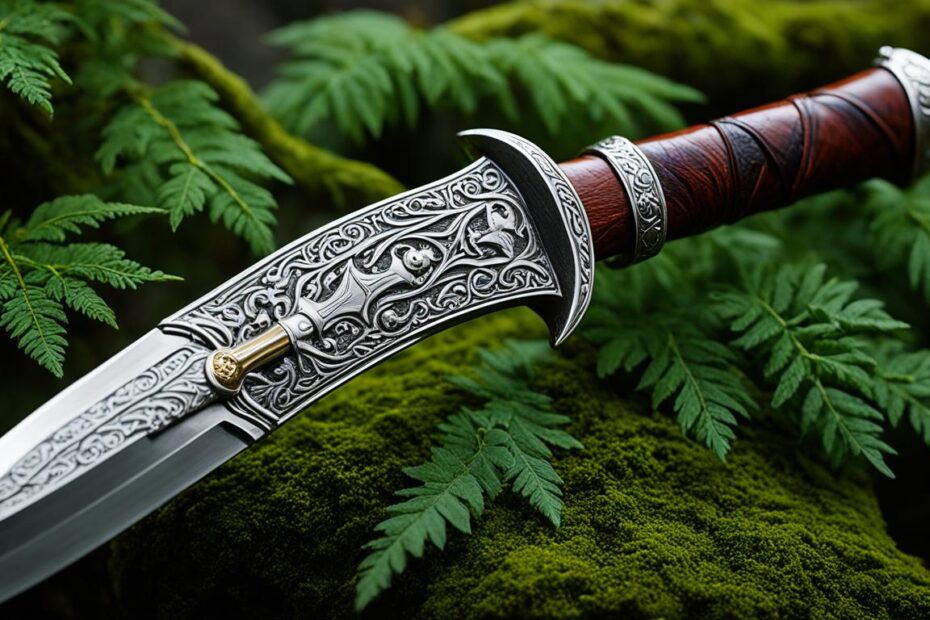Welcome to our exploration of the Sword Ginunting, a magnificent traditional Filipino blade that carries a rich cultural heritage. The Ginunting is more than just a weapon; it represents the craftsmanship and martial arts traditions of the Filipino people. In this article, we will delve into the history, characteristics, and cultural significance of this remarkable blade.
The Sword Ginunting holds a special place in Filipino martial arts, known for its distinct design and practical applications. With a curved blade and a unique shape, the Ginunting is adept at close-quarters combat and self-defense techniques. Its versatility and effectiveness make it an indispensable part of Filipino martial arts training.
But the Sword Ginunting is more than just a weapon of war. It carries a profound cultural significance that stretches back through history. Passed down from generation to generation, the Ginunting embodies the resilience, honor, and traditions of the Filipino people.
In the following sections, we will take a closer look at the history, characteristics, and legacy of the Sword Ginunting. Join us on this journey as we unravel the captivating story behind this traditional Filipino blade and discover why it continues to captivate martial artists and enthusiasts alike.
The History of Sword Ginunting
The Sword Ginunting has a rich and fascinating history that is deeply rooted in Filipino culture and martial arts. Its origins can be traced back to ancient times when it was an essential weapon in combat and self-defense.
The Filipino blade, also known as the Ginunting, has evolved over the years, adapting to different influences and styles. It has been shaped by the diverse historical events and notable figures that have influenced Filipino martial arts.
“The Ginunting is more than just a weapon. It’s a symbol of our heritage and a testament to the Filipino warrior spirit.” – Grandmaster Antonio Reyes
Throughout history, the Ginunting has been wielded by warriors and fighters in various battles and conflicts. Its versatility and unique design made it a favored weapon for Filipino martial artists, who used it to execute swift and precise strikes in close-quarters combat.
The Origins of Ginunting
The exact origins of the Sword Ginunting are shrouded in the mists of time. However, it is believed to have originated from the Moro people, who have a long-standing tradition of bladed weaponry and martial arts. These skilled warriors honed their craft and developed the Ginunting to suit their specific needs in combat.
Over the centuries, the Ginunting spread throughout the archipelago, adapting to different regions and styles of martial arts. It became an integral part of Filipino culture and a symbol of strength, bravery, and honor.
To this day, the Ginunting continues to be revered and respected by practitioners of Filipino martial arts, who recognize its historical significance and carry on the traditions of their ancestors.

Stay tuned for the next section, where we will explore the unique characteristics and practical uses of the Sword Ginunting.
Characteristics and Uses of Sword Ginunting
The Sword Ginunting possesses distinct physical characteristics that make it a remarkable weapon in Filipino martial arts. Its design is characterized by a curved single-edge blade, tapering towards the point, and a sharp, angular tip. The blade’s shape allows for quick and precise strikes, making it effective in close-quarters combat.
Traditionally, Ginunting swords were crafted with meticulous attention to detail, using high-quality materials such as steel and hardwood. The blade’s construction ensures durability and resilience, enabling it to withstand intense training and combat situations.
One notable feature of the Ginunting is its ergonomic handle, designed for a comfortable grip and optimal control. The handle is often made from materials such as bone or wood, allowing the practitioner to wield the sword efficiently and execute various techniques with ease.
The Sword Ginunting’s unique design and craftsmanship contribute to its versatility and effectiveness as a weapon.
The Ginunting is known for its versatility in combat scenarios. Its agility and maneuverability make it suitable for both offensive and defensive techniques. The sword’s curved blade facilitates quick slashes, enabling the wielder to swiftly strike their opponent and create openings for follow-up attacks.
In Filipino martial arts, the Ginunting is often utilized in close-quarters combat, as its compact size and superior control make it ideal for fighting in confined spaces. It allows practitioners to employ intricate deflections, locks, and disarms, enhancing their self-defense capabilities.
Moreover, the Ginunting’s versatility extends beyond martial arts applications. It has become increasingly popular in the world of modern self-defense due to its compact size, ease of concealability, and effectiveness in close-quarters encounters.
An Image Illustrating the Sword Ginunting
With its unique characteristics and practical applications, the Sword Ginunting continues to be an integral part of Filipino culture and martial arts. Its rich heritage and cultural significance make it a symbol of Filipino identity and craftsmanship.
Legacy and Cultural Significance
The Sword Ginunting holds a cherished place in Filipino culture, with its heritage deeply woven into the fabric of the nation. This traditional blade embodies the indomitable spirit of the Filipino people, serving as a symbol of their resilience and martial prowess.
Throughout history, the Ginunting has played a pivotal role in various aspects of Filipino life. From warfare to ceremonies, this blade holds cultural significance that extends far beyond its practical uses. In Filipino martial arts, the Ginunting is revered as a versatile weapon, renowned for its speed, precision, and effectiveness in close-quarters combat.
But the cultural significance of the Sword Ginunting goes beyond its martial applications. It is a cherished artifact that embodies the country’s heritage and traditions. The craftsmanship and artistry employed in creating a Ginunting are a testament to the skill and ingenuity of Filipino artisans. Passed down through generations, the Ginunting represents a connection to the past and serves as a reminder of the values and virtues upheld by the Filipino people.
In modern times, we see the enduring influence of the Sword Ginunting in various forms. From artwork and literature to movies and video games, the cultural legacy of this blade continues to captivate and inspire. Artists and enthusiasts pay homage to its history and cultural significance by incorporating its iconic shape and symbolism into their creations.
